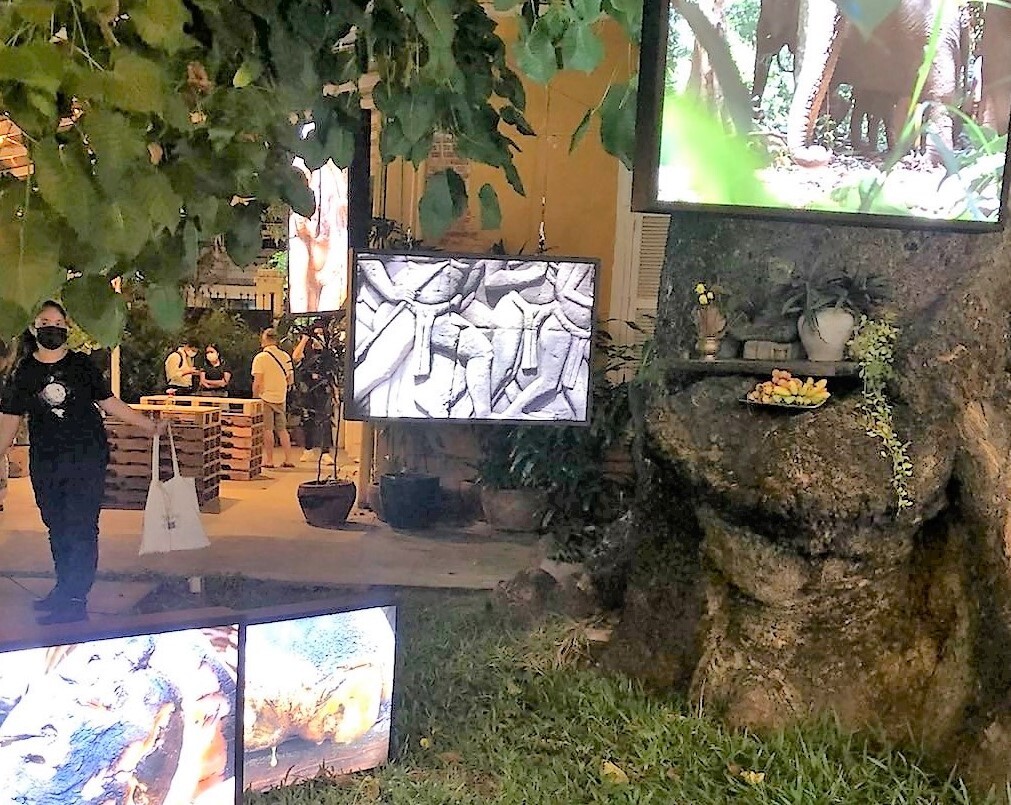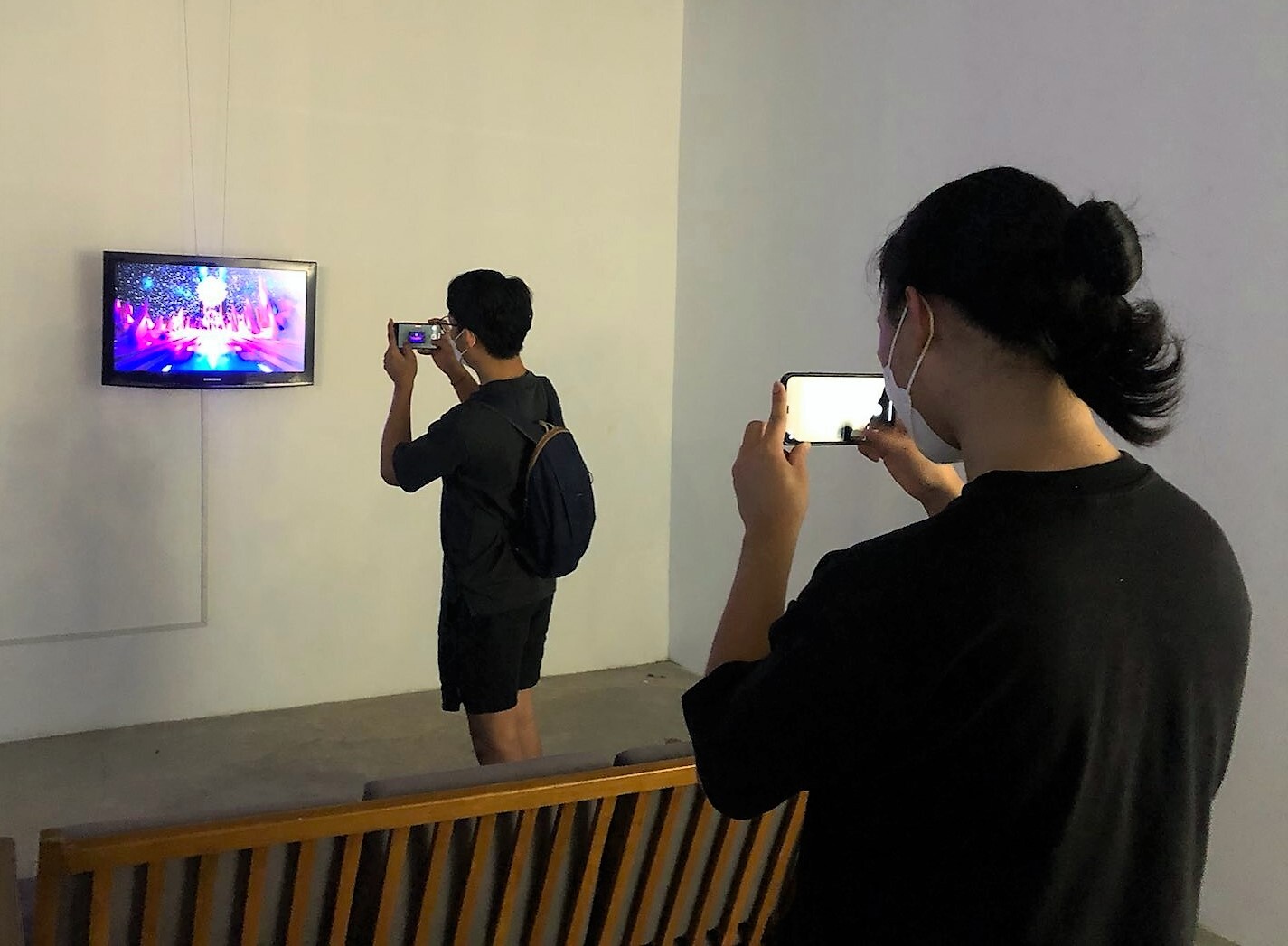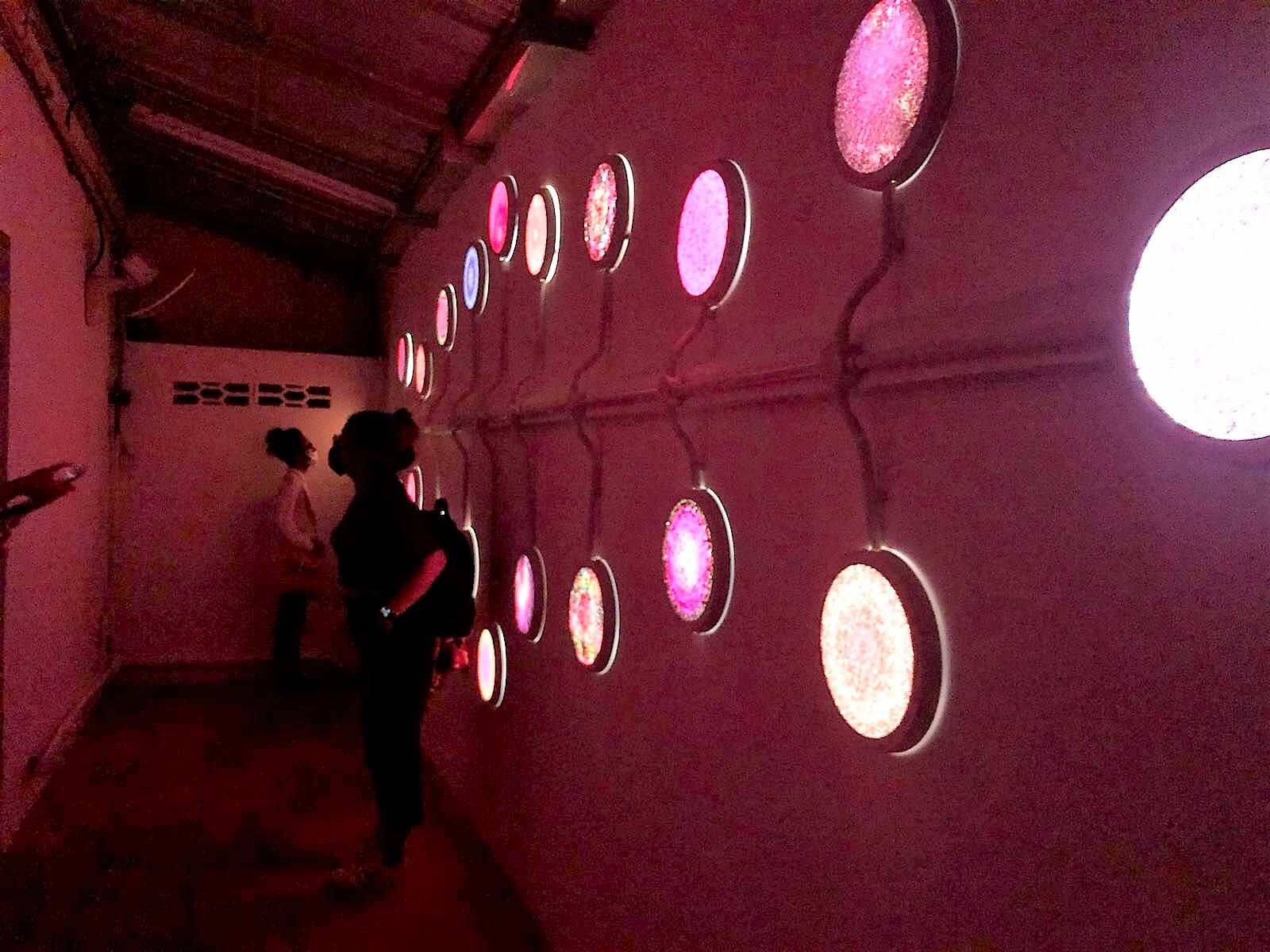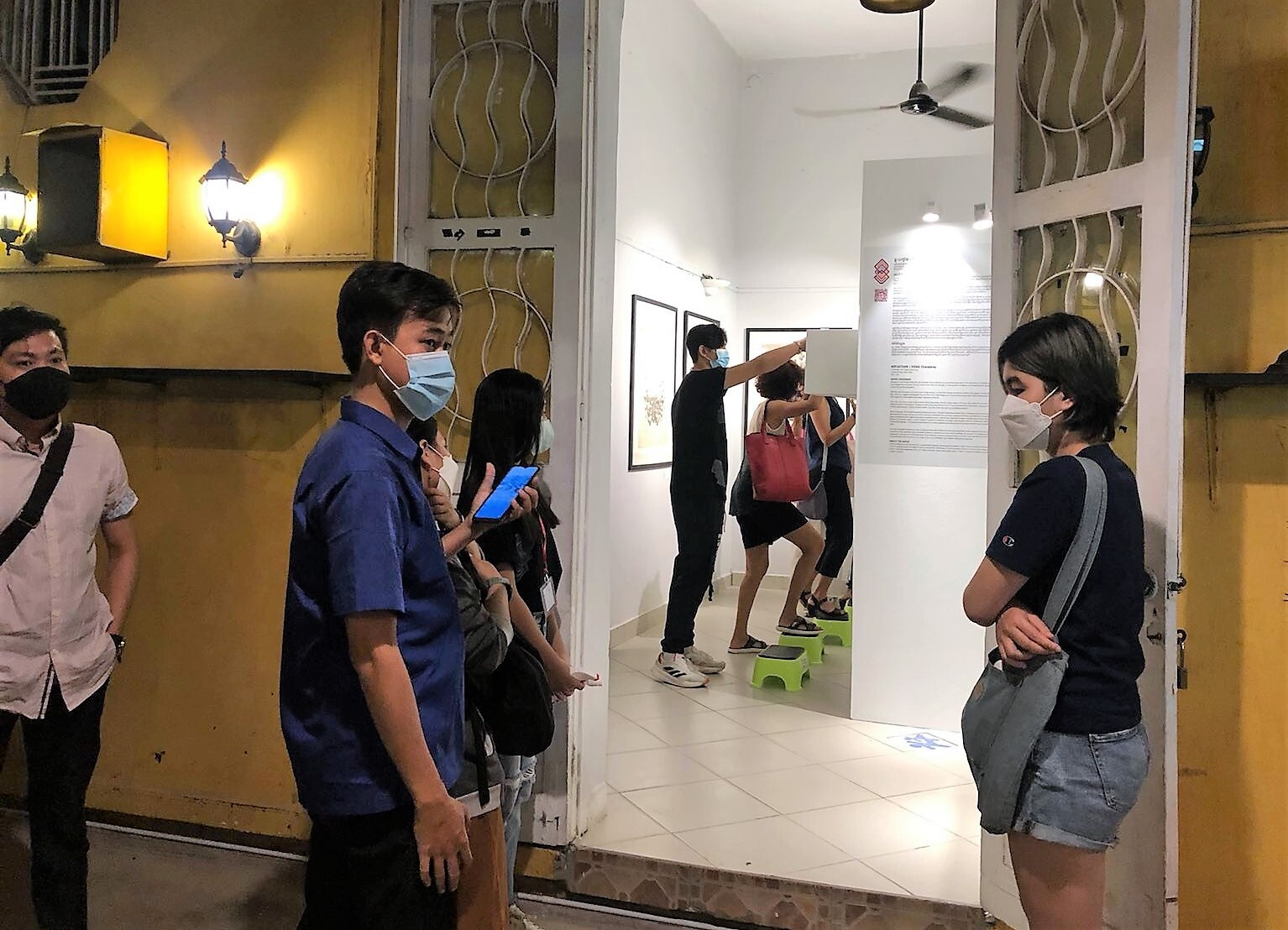The apsara dancers put their hands together in a final bow, but it wasn’t a cue to go home. Some in the audience lingered near a tree where photographs of elephants were suspended amid the foliage. Others peered through peepholes to examine a fine-line drawing exhibit. A few closed their eyes as they entered a gentle meditation soundscape.
It was a scene impossible to fashion virtually: a queer dance troupe blessing the opening of five art exhibits, each designed to pique different senses from sight to sound to touch, as at least 100 people spilled across the Friends Futures Factory in Phnom Penh’s Riverside neighbourhood.

Conversations were punctuated by laughter, the clink of wine glasses and greetings between friends and strangers.
“It’s not just the exhibits,” said Mech Choulay, whose elephant photographs adorned the tree. “It’s about connecting with each other, reacting, touching, feeling, the physical part.”
Dubbed ‘Worlds Unknown,’ the 10-day art festival from 4-14 February aimed to combine seemingly disparate ideas and reimagine how to engage with art two years into the Covid-19 pandemic.
The electric buzz of togetherness remained as the crowd shifted between the ambitious array of events, which in addition to the dance troupe included a meditation session, an archiving talk, a poetry night, school visits, a DJ accompaniment and a potluck dinner.
“This is a week to be with each other,” Choulay said.
Choulay and four other artists, Kong Siden, Ry Roun, Vong Chandarey and Song Seakleng, were the most recent grantees from Creative Generation, a mentorship programme for Cambodian artists.
The grants were intended to culminate in solo exhibits in February 2021. But Covid-19 lockdowns arrived just three days before the first show’s launch, forcing Phnom Penh residents inside their homes and the artists to rethink the year ahead.
“It was all very unsure – just wait, wait, wait, wait, wait,” said Dana Langlois, executive director of Creative Generation.
As the artists met virtually, they came to a consensus: rather than waiting to stage their shows one by one, they would host a joint festival, melding concepts as distinct as Roun’s black-and-white documentarian project and Seakleng’s digital installation, which had the look of a video game.
“Our art practice really feels similar to each other, but from a different perspective,” Siden said. “We’re talking about contemporary issues and situations.”

The most journalistic installation was Roun’s work, a series of shots captured in northeastern Cambodia. Starting in 2018, when the completion of two hydroelectric dams forced about 5,000 villagers from their homes, the freelance photographer took several trips to Kbal Romeas to document the remaining community.
With the old village mostly abandoned after schools, monasteries and farmlands flooded, some villagers tried to start over in the nearby jungle. Photos showed the day-to-day tableau of kids splashing in a stream and the bustle of rice harvesting. The images also revealed the village left behind: The frame of an abandoned house rising out of the flooded land; forgotten family photos inside a ruined home.
“Their lives are stuck,” Roun said. “They’re trying to survive, because there’s nothing there.”
Choulay’s work was similarly grounded, with a photo series and video inviting viewers to enter the inner lives of elephants. Although long a powerful symbol in Cambodia, the animal population has suffered from poaching and deforestation. During the Vietnam War, American bomber planes aiming for suspected communist camps killed or maimed elephants.
Today, an estimated 400 to 600 elephants live in the southwest and northeast of the country. The most dramatic image at the festival, splashed across an entire wall, was a portrait of an elephant blinded in one eye. Choulay wanted to convey the idea: “Animals cannot talk, but what is behind their story?”
At first glance, the exhibits by Choulay and Roun stood in stark contrast to the other three, which were more artistic and imaginative than documentary. But the common thread was each artist’s unique way of dropping the viewer into a place they’ve never been before, Langlois said.
“I felt like there was a sense of discovery in every piece, there was a sense of going into a world that maybe we didn’t normally experience daily,” she said.
The work of Vong Chandarey, a self-taught artist from Battambang, was rife with discovery and a sense of whimsy. Almost hidden in a cosy corner of the venue where just a handful of people could squeeze at a time, visitors looked through peepholes to find his intricate ink drawings detailing suspended worlds. In one, a sprawling tree sprouted out of a floating chunk of earth; in another, a person seated on a rock stared into the abyss as a clock hung from a cloud above.

Seakleng’s digital installation, which riffed on the idea of Buddha’s halo lights, created a different sense of mesmerising unreality. One wall-sized projection showed a hand reaching for a light just beyond its grasp as halos shimmered in the background. On a smaller screen nearby, a digitally rendered person ran along a road toward a rotating light, never seeming to gain ground.
Even those abstractions had a connection to the physical world. Seakleng said he was inspired to combine Buddha’s halo lights and hip-hop music as he drove around Phnom Penh and noticed how the streetlights seemed to pulse to the hip-hop music blaring on his stereo.
Siden was more directly influenced by the realities of Covid-19. As he tried to manage his intense anxiety at the start of the pandemic, he wanted to create something mirroring his mix of emotions.
Viewers walking into his dark exhibit were greeted by the sound of meditative gongs and an array of spherical orbs hanging from the wall in speckled colours, made up of hundreds of abstracted photographs.
While the shifting textures and colours appeared overwhelming at first, Siden said they also invited the viewers to practice mindfulness. “The reality of life is change,” he said. “Sometimes it’s unexpected, and it’s painful, and we still have to adapt and accept it.”

With the loss of international tourists in Phnom Penh during the past two years, contemporary artists in particular have struggled to find audiences to sustain them. Some have collaborated with other artists, shifted toward arts education or hosted events online.
But enticing the public to physically experience their built environment and engage with people around them required more than a typical, three-month gallery show, Langlois said.
“There’s an interactive element throughout the whole exhibition to re-engage our senses – how we interact with people, spaces, our community,” she said.
That approach is backed by scores of research. Tristi Brownett, a Canterbury Christ Church University senior lecturer in public health and health promotion, studies how festivals contribute to community health and has found they create social capital lasting long after the event ends.
There’s an interactive element throughout the whole exhibition to re-engage our senses – how we interact with people, spaces, our community”
Dana Langlois, executive director, Creative Generation
Part of that comes down to cynefin, or the Welsh word for ‘habitat’ – a feeling of connectedness to physical surroundings as well as heritage or history, which combined can make festivals “greater than the sum of their parts,” she said.
A feeling of cynefin was evident in many of the festival’s most thoughtful designs. Choulay’s elephant photos were placed near the tree so people would touch the bark and feel the resemblance to elephant skin. A DJ playing in front of Seakleng’s halo projection brought the pulsing light rhythms to life. Roun led a street photography session for budding photographers.
“If you’ve ever read a really good book or seen a really good movie, it’ll stick with you for weeks,” Brownett said. “The value of that shorter event is you’re more likely to have a greater body of people coming together to celebrate their space and their place.”
Throughout the festival’s 10 days, people wandered in and out, some returning day after day and others merely catching brief snatches of a single event. Daytime school groups drew pictures to adorn an empty wall; in the evenings, people sipped wine and nibbled spring rolls under a glittering string of lights.
Even so, the threat of Covid-19 remained an inevitable backdrop. As the week wrapped up, rising omicron cases prompted Prime Minister Hun Sen to call for caution when gathering in person.
But the festival endured and left attendees with what Langlois said she hoped was a sense of ownership.
“I’m part of this, I want to give to this,” she said. “This is for me and for us. I’m not just being entertained.”
Photos by Fiona Kelliher for Southeast Asia Globe


